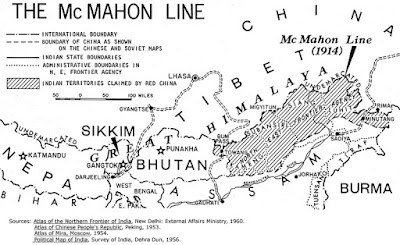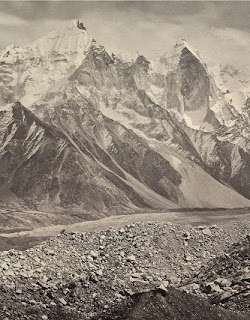I recently attended the launch
events of two newly published books relating to the Himalayas. Although the two
books focus on different countries they tell two similar tales concerning the
regretful demise of two nominally independent Himalayan states – Tibet and
Sikkim.
As the high era of Western
Imperialism in East Asia was drawing to a close in the first half of the twentieth
century many of the different polities in the region were vying to maintain or
establish international recognition of their own sovereign legitimacy. In the
wake of US President Woodrow Wilson’s speech of 11th February 1918, advocating ideas of
national ‘self-determination’, and the active
indigenous intellectual project of envisaging a future post-colonial
era, this struggle for sovereignty meant that many smaller states and
former protectorates found themselves precariously over-shadowed by their larger and more
powerful neighbours.[1] Sikkim and Tibet being two distinct examples.
 |
| In 1913-1914 the Simla Conference attempted to establish international boundaries between British-India, Tibet and China |
The boundaries of such
polities had always been rather vague in Western terms. Not so much represented
by lines on accurately surveyed maps, but rather delineated by a complex,
web-like skein of distinct social, cultural, political, economic, and religious
ties. During the long period of British administration in India, the Himalayan
states to the north, despite being perceived as peripheral regions, nonetheless,
were keenly watched as regions of great strategic importance, increasingly
becoming the source of much imperial anxiety. In the so-called ‘Great Game’ of
contesting empires the British had always looked warily towards these Himalayan
states and repeatedly attempted to cultivate or coerce them, attempting to establish
them as a kind of politically amenable ‘buffer’ zone between India, Russia, and
China. But later, with the Russian Revolution of 1917, the withdrawal of the
British from India in 1947, and the Chinese Communists finally securing control
after a protracted civil war with the Chinese Nationalists in 1949, the immediate
post-World War 2 era witnessed a new realignment of the geopolitical scene.
India, the USSR, and China each jockeying for the consolidation of power and
influence within the region.
Surveys & Explorations - Himalayas & Central Asia, 1934
In 1950 the newly
established Communist Government in China announced that the People’s
Liberation Army, having secured the Chinese mainland, would now turn its
attention towards the ‘liberation’ of Tibet from its long established feudal form
of monastic government, and thereby bring Tibet firmly back into the Chinese fold.
Meanwhile, in Sikkim the ruling Chogyal – aware that he was no longer protected
by the former British system of administration in India – sought to establish
and assert the legal status of an independent Sikkim along the same lines as
those already recognised with respect to the neighbouring Kingdoms of Nepal and
Bhutan.
Yet, as these two books clearly demonstrate, neither situation was to
end happily for those who considered themselves independent Tibetans or
independent Sikkimese.
Tibet: An Unfinished Story
By Lezlee Brown Halper & Stefan Halper
(Hurst, 2014)
To mark the launch of Tibet: An Unfinished Story the book’s publishers, arranged an interesting discussion
which brought together one of the book’s authors – Stefan Halper, with noted
journalist and China Correspondent, Isabel Hilton, and Sir Richard Dearlove,
former Head of the British Intelligence Service.
The discussion ranged across
the book’s main themes, examining the current situation in ‘Xizang’ or the
‘Tibet Autonomous Region of China’ and the diplomatic impasse between the
Chinese Government, His Holiness the Dalai Lama, and the Tibetan Government-in-exile
in Dharamsala, India. The authors are both academics based at Cambridge
University, and Stefan Halper also previously served in the White House and the
US Department of State, which meant that the discussion regarding today’s Tibet
was a distinctly political one, covering a lot of highly contentious themes – not
least the disappearance of the 11th Panchen Lama, aged just 6 years old in 1995
(which Isabel Hilton has herself written about[2]), and the recent rise in protests by
ethnic Tibetans, particularly in the form of self-immolation, against the present
system of Chinese administration within Tibet which is widely criticised as
being stiflingly repressive.
The discussion did also seek to place the
contemporary situation within a broader historical context, whilst continuing
to look to the future, not least given the uncertainties borne of the recent
changes occurring in China’s increasing economic engagement with the wider world;
speculating how China’s outlook may begin to change as it continues to open up
as part of its continuing ‘peaceful rise’ as a burgeoning new global
‘superpower.’
In this light, rather than
being an overarching history of Tibet, this book is primarily focussed upon an
analysis of United States' Foreign Policy towards Tibet and India, specifically
in the period after the close of World War 2. It examines in detail Henry
Kissinger and Richard Nixon's diplomatic engagement with the People's Republic
of China in the 1970s. The role of India’s first Indian Prime Minister, Jawaharlal
Nehru, also forms a pivotal focus for much of the central portion of the
text. The book does very briefly attempt
to situate this period in relation to Tibet's long and remarkable history prior
to this time (and concludes by giving some comment on recent events, for
example – the unrest during the 2008 Beijing Olympics), but, it’s fair to say
the authors deftly manage to cover this long and complex early phase of Tibet’s
history in a rather slim set of pages at the start of the book, giving just
enough detail to adequately reach its main period of focus which it then
examines in much closer detail. In this sense, as might be expected given the
authors’ backgrounds, Tibet: An Unfinished Story is essentially a political
history of US diplomatic relations with Asia (and the CIA’s covert activities
and involvement with the Tibetan-Khampa armed resistance effort) during the
height of the Cold War era.
Uncompromising in its
sympathy for the cause of Tibetan independence, whilst acknowledging that this has to
a certain extent been mythologised as a perpetual ‘Shangri-La’ by an otherwise effectively
disengaged West, this book is nonetheless a thoroughly researched and firmly grounded
academic analysis – utilising both US and Chinese sources – to examine a deeply
contentious and emotionally complex history.
Sikkim: Requiem For A Himalayan Kingdom
By
Andrew Duff
(Birlinn, 2015)
An article in Time magazine
published in 1959 observed that: “What
happens in Tibet has always echoed in Sikkim.”
Sikkim: Requiem for a Himalayan Kingdom by my friend, Andrew Duff, was published last month. The book
begins as a simple travelogue in which the author embarks upon a trek through
Sikkim to retrace the footsteps of his Grandfather, who had journeyed through
the region in the 1920s, but a chance meeting with a monk at Pemayantse
Monastery prompts Duff to delve deeper into the more recent history of this tiny
former Himalayan kingdom. The compelling story which follows is essentially a
political-biography of Sikkim’s 12th and last Chogyal (or King), Palden Thondup
Namgyal, whose life was entirely dedicated to the struggle to maintain the
semi-independent sovereignty of his native kingdom in the wake of the British
withdrawal from empire in India in 1947.
In 1890, during the time of
the British Raj, Sikkim had become a protectorate of the British Empire, a
status which was nominally maintained after India gained independence and later
affirmed in a treaty signed in 1950 with the Indian Prime Minister, Jawaharlal Nehru.
As a suzerain state, Sikkim remained administratively autonomous whilst
transferring control of its external affairs, defence, diplomacy and
communications to India. Yet Sikkim could not escape the ever looming shadow of ‘Great Game’ machinations which continued between its larger neighbouring
states. Diplomatic relations between the USSR, India and China – particularly
after the Chinese took control of Tibet in 1950 – continued to remain fragile,
and this air of uncertainty only seemed to heighten the geopolitical anxieties
concerning the somewhat nebulous mix of different ethnic polities which reside
in what was still very much perceived to be a highly vulnerable Himalayan
border zone. Unlike neighbouring Nepal and Bhutan, which were both able to
establish their own independent sovereignty in the eyes of the international
community, Sikkim was essentially out-manoeuvred by political forces operating
both within and outside its borders.
A discontented faction
within Sikkim itself – lead by the Kazi and Kazini, Sikkim’s Chief Minister and
his indomitable Scottish wife – increasingly began to agitate against the power
of the Chogyal, pressing for a more democratic system of government. The
Chogyal, relying on the support of the Indian Government, initially resisted
but eventually reluctantly conceded to certain changes which began a process
that gradually eroded the political influence and control hitherto vested
solely in the monarch. But, in the long run, each of these parties was
essentially out-manoeuvred by the Indian Government, under Nehru’s daughter,
Indira Gandhi, who essentially very carefully laid the groundwork for a coup
which was later staged by the Indian military in 1975. A referendum followed suspiciously
swiftly in which a majority reportedly seemed to be favour of Sikkim
relinquishing its sovereignty to become a state within India proper. Even
though the anti-Chogyal faction and the monarch managed to come to an agreement
at the eleventh hour it was too late, each had fallen foul of the duplicity of
Indira Gandhi’s officials operating within both Sikkim and Delhi.
Despite keeping a keen eye
on the sequence of events and confusing political developments taking place
within Sikkim, officials in the US and the UK could offer little beyond
sympathetic platitudes, whilst China and Pakistan used the situation as a
rhetorical lever, as and when it suited their purpose, either to condemn India or absolve their own parallel actions
in other contested regions. Sikkim was sadly seen as simply too small a pawn in
the international politics of the region for its former friends and allies to
be of much help in preserving its autonomy. Whereas Tibet had lost its autonomy
under duress by direct force, as Duff demonstrates, Sikkim had somewhat
unwittingly been progressively hoodwinked by a war of political stealth and attrition.
Andrew Duff very ably
reconstructs the machinations of this era using a variety of sources and
archive material, drawing in particular on the richly personable papers of two
westerners, both women missionary school teachers from Scotland, who each lived and worked
for a number of years in Sikkim throughout this turbulent period, and both of
whom were close to the Chogyal and his second wife, the American Hope Cooke.
Their marriage was originally a glamorous, oriental fairy-tale romance, reminiscent of
American actress Grace Kelly and Prince Rainier III of Monaco, but which
eventually fractured under the personal and political strains of Sikkim’s
struggle. Ultimately Sikkim: Requiem for a Himalayan Kingdom is the story, engagingly told, of the tragedy
which befell a colourful cast of individuals caught and completely churned over
in the tumultuous wake of competing Cold War era leviathans thrashing out a new
international order in the immediate post-colonial fallout of the mid-late twentieth
century.
Read
an interview in which Andrew Duff discusses Sikkim on the Asia House website.
~
Read my review of Karl E. Ryavec's 'A Historical Atlas of Tibet' (University of Chicago Press, 2015) on the LSE Review of Books website.
~
Read my review of Karl E. Ryavec's 'A Historical Atlas of Tibet' (University of Chicago Press, 2015) on the LSE Review of Books website.
[1] See, Erez Manela, The
Wilsonian Moment: Self-Determination and the Origins of Anticolonial
Nationalism (Oxford University Press, 2007)
[2] See, Isabel Hilton, The Search for the Panchen Lama (Norton, 2001)





No comments:
Post a Comment
Comments do not appear immediately as they are read & reviewed to prevent spam.